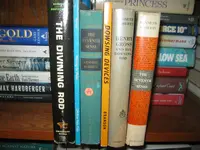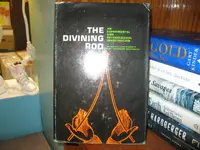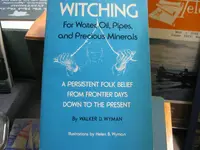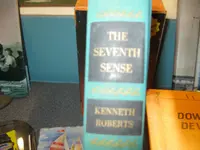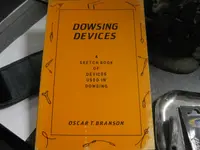Regarding verifiably finding a bottle of water, I think that there may be more consistency than you seem to think. Following a north/south route works for finding a bottle of water during the daytime, but, if the study is done at night, one can find the water bottle regardless of whether they are searching a north/south or east/west path. The study I've designed does include a double blind and, where applicable, random assignment. I've also built in controls to account for time of day, directionality, distance from the bottle of water, and false positives. Besides Educational Psychology, three of my areas of expertise are experimental design, evaluation, and statistics. I've already put myself through the entire rigor of my experimental design.One of the most consistent things about dowsing is... there is no consistency. Everyone seems to have their own peculiarities, requirements, or limitations. I'll bet there's a dowser out there who can only do it in an east/west route, but for most dowsers direction makes no difference.
If you're a psychologist then you are surely familiar with scientific test protocols, such as double-blind clinical trials used in, say, psychiatric studies. The same sort of thing can be applied to dowsing. In the past, I've designed and applied such methods to willing participants and, in every single case, their dowsing ability completely disappeared. You might want to apply some rigor to your self-evaluation before you go too far down the rabbit hole.
You are using an out of date browser. It may not display this or other websites correctly.
You should upgrade or use an alternative browser.
You should upgrade or use an alternative browser.
Want to try Dowsing?
- Thread starter aarthrj3811
- Start date
signal_line
Silver Member
- Joined
- Nov 14, 2011
- Messages
- 3,691
- Reaction score
- 1,913
- Golden Thread
- 0
- Detector(s) used
- XP Deus
- Primary Interest:
- All Treasure Hunting
Signal line is a bundle of magnetic lines of force between a generator and the target. The human brain emits energy same as light waves. Or you can use a frequency generator type locator to create the bundle effect to the resonating target.Please explain what you mean by "target line". I've never heard of that before. And, as for L-shaped rods, they work for me and, if I can show this in a controlled study then the world might, finally, stop thinking of (at least water dowsing) as something more than hocus-pocus stuff
Please tell me more and/or tell me where I can discover what you're talking about. I've never heard of "using" frequenciesI was hoping for copper or silver?
signal_line
Silver Member
- Joined
- Nov 14, 2011
- Messages
- 3,691
- Reaction score
- 1,913
- Golden Thread
- 0
- Detector(s) used
- XP Deus
- Primary Interest:
- All Treasure Hunting
When you are walking with a rod there is a sensitivity to objects that are 90 degrees from youSignal line is a bundle of magnetic lines of force between a generator and the target. The human brain emits energy same as light waves. Or you can use a frequency generator type locator to create the bundle effect to the resonating target.
I’m not positive as to if it would work that was a question for you guysPlease tell me more and/or tell me where I can discover what you're talking about. I've never heard of "using" frequencies
Carl-NC
Bronze Member
- Joined
- Mar 19, 2003
- Messages
- 1,942
- Reaction score
- 1,558
- Golden Thread
- 0
- Location
- Washington
- Detector(s) used
- Custom Designs and Prototypes
- Primary Interest:
- All Treasure Hunting
That's your belief. Other dowsers will disagree. Why do you think that is?Regarding verifiably finding a bottle of water, I think that there may be more consistency than you seem to think. Following a north/south route works for finding a bottle of water during the daytime, but, if the study is done at night, one can find the water bottle regardless of whether they are searching a north/south or east/west path.
Can you describe your test procedure?The study I've designed does include a double blind and, where applicable, random assignment. I've also built in controls to account for time of day, directionality, distance from the bottle of water, and false positives. Besides Educational Psychology, three of my areas of expertise are experimental design, evaluation, and statistics. I've already put myself through the entire rigor of my experimental design.
It is a common belief with dowsers that elements resonate at characteristic frequencies and if you "tune in" to, say, the frequency of gold then gold is what you will find. From this there grew an entire industry of "long range locators" which are basically dowsing rods with some electronics added that supposedly generate frequencies for gold silver, and so forth.Please tell me more and/or tell me where I can discover what you're talking about. I've never heard of "using" frequencies
A major problem with this is that most dowsers don't agree on what those frequencies are. They all seem to come up with their own. Same with the LRL makers -- they mostly use different frequencies, and some don't even bother to generate any kind of signal; they have knobs and switches that don't actually do anything.
Too much to describe in a post. Here is a draft pdf of the study design. Let me know what you think! I'm a novice when it comes to water dowsing but, from what I've seen, I'll be surprised if the study doesn't end up giving water dowsing some scientific credence.
Attachments
Last edited:
signal_line
Silver Member
- Joined
- Nov 14, 2011
- Messages
- 3,691
- Reaction score
- 1,913
- Golden Thread
- 0
- Detector(s) used
- XP Deus
- Primary Interest:
- All Treasure Hunting
Too much toWhen you are walking with a rod there is a sensitivity to objects that are 90 degrees from you
A frequency generator sends a wave out that hits the target and if it matches the resonant frequency it excites the target. There is a lot more to it than thatPlease tell me more and/or tell me where I can discover what you're talking about. I've never heard of "using" frequencies
signal_line
Silver Member
- Joined
- Nov 14, 2011
- Messages
- 3,691
- Reaction score
- 1,913
- Golden Thread
- 0
- Detector(s) used
- XP Deus
- Primary Interest:
- All Treasure Hunting
Konstantin Meyl did some work with scalar waves very similarToo much to
A frequency generator sends a wave out that hits the target and if it matches the resonant frequency it excites the target. There is a lot more to it than that
dowser
Bronze Member
I doubt you'll have too many Dowsers show up to Dowse a teaspoon of water. I know I couldn't do it.To much to describe in a post. Here is a draft pdf of the study design. Let me know what you think! I'm a novice when it comes to water dowsing but, from what I've seen, I'll be surprised if the study doesn't end up giving water dowsing some scientific credence.
I've learned sensitivity is an enemy. The smaller the signals dowsed, the more there are.. You can't accomplish your goals, Dowsing thru a spider web of junk..
Last edited:
dowser
Bronze Member
Dowsers have different reception abilities.I doubt you'll have too many Dowsers show up to Dowse a teaspoon of water. I know I couldn't do it.
I've learned sensitivity is an enemy. The smaller the signals dowsed, the more there are.. You can't accomplish your goals, Dowsing thru a spider web of junk..
I can Dowse signal, 1 gram per foot..
I have to be within 26 foot for a Silver dollar, 2 1/2 feet from a dime, to Dowse it using one ounce.. It used to be stronger and dowse further in the past.. Microwaves have knocked the strength down, some places more than others..
Carl-NC
Bronze Member
- Joined
- Mar 19, 2003
- Messages
- 1,942
- Reaction score
- 1,558
- Golden Thread
- 0
- Location
- Washington
- Detector(s) used
- Custom Designs and Prototypes
- Primary Interest:
- All Treasure Hunting
Some questions:Too much to describe in a post. Here is a draft pdf of the study design. Let me know what you think! I'm a novice when it comes to water dowsing but, from what I've seen, I'll be surprised if the study doesn't end up giving water dowsing some scientific credence.
- Why only a TBSP of water? Seems like that creates an unnecessary difficulty.
- How is the randomized placement of the target selected?
- How did you come up with a 60% threshold for chance? 60% of what?
- Doing this test indoors invites all kinds of post-test complaints and alibis, even if each dowser does a pretest trial to check for anomalies. There are bound to be water pipes in the building that hold far more water than the 1 TBSP target.
- The room divider is unnecessary. As long as the dowser isn't allowed to see the placement of the target, it's fine for them to see the containers as long as they're opaque. Just make sure each container gets equally disturbed during target placement.
- You don't mention any pre-trial runs where the dowser knows the location of the target. This is useful for establishing a baseline.
Actually it was a tablespoon. Regardless, how much water would you suggest?I doubt you'll have too many Dowsers show up to Dowse a teaspoon of water. I know I couldn't do it.
I've learned sensitivity is an enemy. The smaller the signals dowsed, the more there are.. You can't accomplish your goals, Dowsing thru a spider web of junk..
I haven't tried. I did to a test run, but it was a daytime East/West run before I found out about the differences between East/West and North/SouthSome questions:
Some observations:
- Why only a TBSP of water? Seems like that creates an unnecessary difficulty.
- How is the randomized placement of the target selected?
- How did you come up with a 60% threshold for chance? 60% of what?
Finally, did you do this test yourself, with all the rigors in the test document?
- Doing this test indoors invites all kinds of post-test complaints and alibis, even if each dowser does a pretest trial to check for anomalies. There are bound to be water pipes in the building that hold far more water than the 1 TBSP target.
- The room divider is unnecessary. As long as the dowser isn't allowed to see the placement of the target, it's fine for them to see the containers as long as they're opaque. Just make sure each container gets equally disturbed during target placement.
- You don't mention any pre-trial runs where the dowser knows the location of the target. This is useful for establishing a baseline.
What would be the benefit of establishing a baseline? I am going to have the professional dowsers go through a trial run of the test to insure that they can meet the better than chance criterion.Some questions:
Some observations:
- Why only a TBSP of water? Seems like that creates an unnecessary difficulty.
- How is the randomized placement of the target selected?
- How did you come up with a 60% threshold for chance? 60% of what?
Finally, did you do this test yourself, with all the rigors in the test document?
- Doing this test indoors invites all kinds of post-test complaints and alibis, even if each dowser does a pretest trial to check for anomalies. There are bound to be water pipes in the building that hold far more water than the 1 TBSP target.
- The room divider is unnecessary. As long as the dowser isn't allowed to see the placement of the target, it's fine for them to see the containers as long as they're opaque. Just make sure each container gets equally disturbed during target placement.
- You don't mention any pre-trial runs where the dowser knows the location of the target. This is useful for establishing a baseline.
dowser
Bronze Member
You would have to allow the Dowser make sure the area is clear.Actually it was a tablespoon. Regardless, how much water would you suggest?
I would place 5 different Elements under 5 cups. Using 5 duplicate elements, have the Dowsers, Dowse each one to the correct cup. Only 4 are needed, then your a Dowser.. Pendulum or rods, your in..
ROBOTCOP13
Sr. Member
- Joined
- Jul 29, 2014
- Messages
- 300
- Reaction score
- 436
- Golden Thread
- 0
- Primary Interest:
- All Treasure Hunting
My friend is going thru her book collection getting ready for the Florida Antiquarian Book Fair next month and I spotted a couple of "classic " books on dowsing. Some from the fifties and signed by authors. Iconic covers. Wealth of knowledge, pre-internet!
Attachments
Some questions:
Some observations:
- Why only a TBSP of water? Seems like that creates an unnecessary difficulty.
- How is the randomized placement of the target selected?
- How did you come up with a 60% threshold for chance? 60% of what?
Finally, did you do this test yourself, with all the rigors in the test document?
- Doing this test indoors invites all kinds of post-test complaints and alibis, even if each dowser does a pretest trial to check for anomalies. There are bound to be water pipes in the building that hold far more water than the 1 TBSP target.
- The room divider is unnecessary. As long as the dowser isn't allowed to see the placement of the target, it's fine for them to see the containers as long as they're opaque. Just make sure each container gets equally disturbed during target placement.
- You don't mention any pre-trial runs where the dowser knows the location of the target. This is useful for establishing a baseline.
1. I probably should use a larger capped bottle of water
2. I used the excel function =RANDBETWEEN(1,10)
3. I'd have to have my probabilities guru provide the real answer. I would think that the answer is largely dependent upon the value chosen for p. I think he used .01. But, regardless, there is no rule regarding what value of p you should use
2. I used the excel function =RANDBETWEEN(1,10)
3. I'd have to have my probabilities guru provide the real answer. I would think that the answer is largely dependent upon the value chosen for p. I think he used .01. But, regardless, there is no rule regarding what value of p you should use
Similar threads
Users who are viewing this thread
Total: 1 (members: 0, guests: 1)



